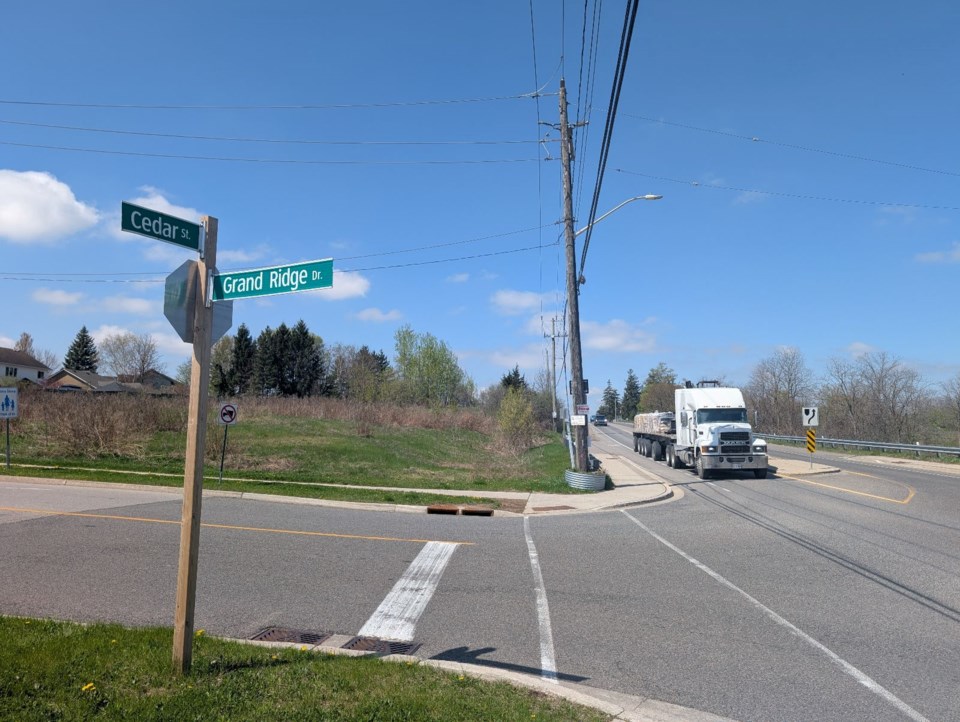This article was previously published on CambridgeToday.
Cambridge council will ask regional council to direct its staff to implement safety measures at a west Galt intersection and monitor the area, as part of plans to move forward with an affordable housing development on city-owned land.
At its Tuesday evening meeting, council approved rezoning and an official plan amendment to move forward with an affordable housing proposal at 579 Grand Ridge Dr. on an acre of city-owned land.
The zoning bylaw and official plan amendment approvals allow a four-storey apartment with a maximum of 50 units at the corner of Grand Ridge Drive and Cedar Street/Cedar Creek Road, a regionally controlled intersection.
The development at 579 Grand Ridge Dr. is the second proposal on city-owned land seeing a fast-tracked process to create affordable housing to meet a quota outlined by the federal government’s Housing Accelerator Fund (HAF).
In April, council approved a four-storey residential building at the former St. Ambrose School site, purchased by the city in 2019, on Chalmers Street. No exact figure was given for the number of units at that proposal but a conservative estimate used 228 units to conduct a traffic study.
The two projects are among goals the city needs to meet for the HAF to access more than $13 million in funding through the Canada Mortgage and Housing Corporation.
Although several letters included with the recommendation report expressed concern over traffic at the nearby intersection, a traffic and safety study didn’t recommend any improvements at the intersection under any growth scenario through 2035 that fall within the city's jurisdiction.
Senior planner Nicole Goodbrand noted future conditions at the intersection would lead to a decline in service levels with or without the development of the site.
Councillor Helen Shwery said she took a drive to the area prior to the council meeting and believed there to be a disconnect from what the traffic study says and what the reality is.
“Perhaps we need to tweak the algorithms to support the reality of it because it doesn’t currently from what I’m seeing,” Shwery said, adding she was concerned about a lack of sidewalks, bike paths, traffic lights or pedestrian crossings.
Shannon Noonan, Cambridge’s manager of transportation, stressed traffic studies are done by professionals and staff rely on the results of it.
“I do understand that people do maybe feel a little bit differently when they’re actually there driving, they may feel that there are longer delays, no gaps perhaps for making their turns … but that certainly is all accounted for in the transportation study,” Noonan said.
Mayor Jan Liggett wanted staff to begin conversations with the region about a traffic light at the intersection, although the traffic study didn’t identify one, to get ahead of a potential future problem.
“I know there was talk with the public that because of the hill, that can’t happen,” Liggett said. “I’d like to remind people that they said that for years about Shantz Hill.”
After delegations from members of Citizens for Cambridge and Waterloo Region YIMBY encouraging council to move forward with the housing proposal, councillor Sherri Roberts made an amendment to the motion to ask the region for safety improvements at the intersection including:
- A transition speed zone of 60 km/h between the current 50 km/h and 80 km/h zones
- Adding peripheral transfers pavement markings in the transition zone
- Moving the 50 km/h zone further to the west
- Providing advanced street name signage
- Installing pedestrian yield and pedestrian ahead signs
- Requesting the region to annually monitor the intersection for traffic signals
Roberts said she lives nearby and finds it to be a troubling intersection.
“Eventually street lights are required there and I don’t want us to have to wait to do a whole other traffic impact study,” Roberts said.
Liggett clarified this amendment is merely a “polite request” and council can’t force the region to do anything.
The amendment and original recommendation passed unanimously with councillor Mike Devine not present at the meeting.




